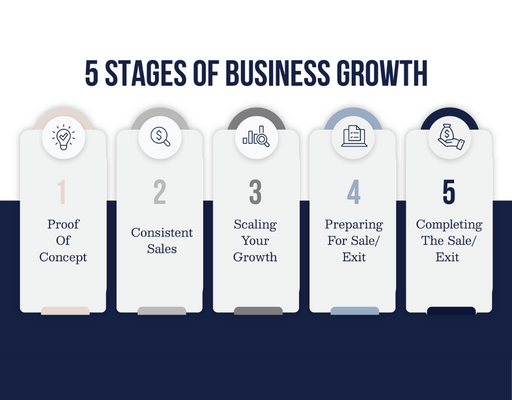Growing a business is a journey that starts with a single idea and can end with a successful exit. Along the way, there are certain milestones that a business generally goes through to reach an eventual exit.

I like to talk about these milestones as 5 stages of business growth.
1. Proof of Concept
The first stage of business growth is proof of concept. This is when you are just starting out and trying to prove that your product or service is something that people actually want to buy. At this stage, you may only have a few initial sales, like your first 20-50 sales.
The key objective at this stage is to focus on getting some initial traction and proving that there is a market for what you are offering.
2. Consistent Sales
Once you have proven that there is a market for your product or service, the next stage of business growth is achieving consistent sales. This means building systems and processes that allow you to make consistent sales on a regular basis. This could include things like setting up automated marketing campaigns, streamlining your sales process, having properly documented processes, and hiring additional staff to help with the workload.
As part of this phase, you ideally should begin removing yourself from the day to day operations as much as you can if you are the business owner.

3. Scaling Your Growth
The third stage of business growth is scaling your growth. This means expanding your business in a way that allows you to reach more customers and increase your revenue. This could involve expanding your existing marketing channels, entering new markets, acquiring other companies, or adding new revenue streams such as licensing or cloning your business model in different niches.
If you haven’t already done so, by this phase you should have removed yourself from most of the day to day operations if you are the business owner. It’s more difficult to scale your business if you are too deep in the trenches of the operations. At this stage, it is also important to start building relationships with other companies that may be interested in a future acquisition and to start putting intellectual property protections in place for your most valuable company assets if you haven’t already.
4. Preparing For Sale/Exit
The fourth stage of business growth is preparing for sale or exit. This means taking steps to make your business as attractive as possible to potential acquirers and ensuring that it will be valued at the highest multiple possible. This could involve things like streamlining operations even further, improving profitability, adding more recurring revenue, confirming that your most valuable intellectual property assets have been registered or properly protected, and making sure the systems you have in place can continue to run smoothly without you.

It is also important to start thinking about your desired exit strategy and tax savings strategy at this stage. For example, do you want to sell your company to a third party, or to your employees as part of an ESOP plan? How can you structure a large cash sale in a way that you can minimize the payment of income taxes on the sale?
5. Completing The Sale/Exit
The final stage of business growth is completing the sale or exit. This means successfully selling your business to a third party and realizing the fruits of all your hard work. This can be a complex and emotional process, so it is important to have a clear plan in place and to work with experienced advisors who can help guide you through the process.
There are various companies out there that can help you achieve these various stages of growth. At my consulting company, we primarily focus on helping companies go from stage 2 to stage 3 or from stage 3 to stage 4. If you are in one of those stages and would like my team to build you a free roadmap to show you our unique process from getting you to the next stage, you can book a free roadmap session here.
If you like the plan that we put together for you and want us to help you implement it, we’ll also tell you what that would look like. No pressure either way. We just want to help you grow to the next stage of business and continue reaching your goals.
By focusing on each of these milestones and continually striving to reach the next stage, you can increase your chances of building a successful and profitable business.












